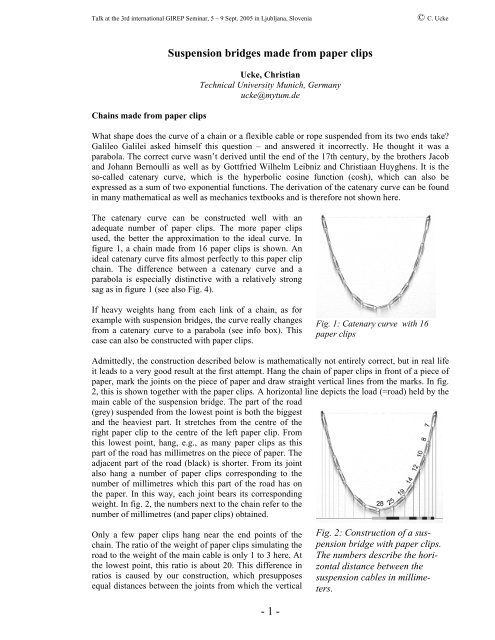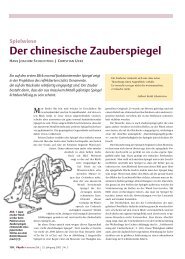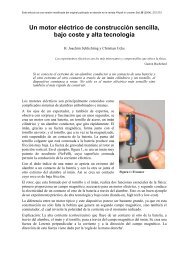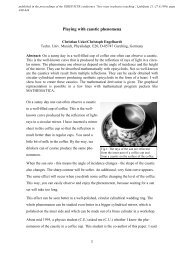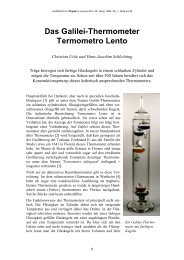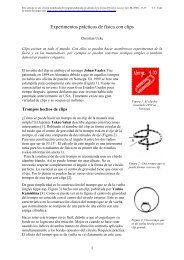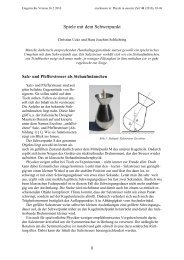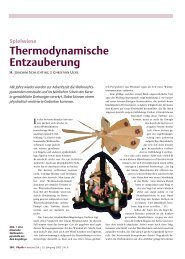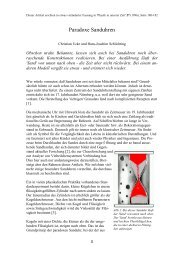Suspension bridges with paper clips
Suspension bridges with paper clips
Suspension bridges with paper clips
You also want an ePaper? Increase the reach of your titles
YUMPU automatically turns print PDFs into web optimized ePapers that Google loves.
Talk at the 3rd international GIREP Seminar, 5 – 9 Sept. 2005 in Ljubljana, Slovenia<br />
© C. Ucke<br />
Chains made from <strong>paper</strong> <strong>clips</strong><br />
<strong>Suspension</strong> <strong>bridges</strong> made from <strong>paper</strong> <strong>clips</strong><br />
Ucke, Christian<br />
Technical University Munich, Germany<br />
ucke@mytum.de<br />
What shape does the curve of a chain or a flexible cable or rope suspended from its two ends take?<br />
Galileo Galilei asked himself this question – and answered it incorrectly. He thought it was a<br />
parabola. The correct curve wasn’t derived until the end of the 17th century, by the brothers Jacob<br />
and Johann Bernoulli as well as by Gottfried Wilhelm Leibniz and Christiaan Huyghens. It is the<br />
so-called catenary curve, which is the hyperbolic cosine function (cosh), which can also be<br />
expressed as a sum of two exponential functions. The derivation of the catenary curve can be found<br />
in many mathematical as well as mechanics textbooks and is therefore not shown here.<br />
The catenary curve can be constructed well <strong>with</strong> an<br />
adequate number of <strong>paper</strong> <strong>clips</strong>. The more <strong>paper</strong> <strong>clips</strong><br />
used, the better the approximation to the ideal curve. In<br />
figure 1, a chain made from 16 <strong>paper</strong> <strong>clips</strong> is shown. An<br />
ideal catenary curve fits almost perfectly to this <strong>paper</strong> clip<br />
chain. The difference between a catenary curve and a<br />
parabola is especially distinctive <strong>with</strong> a relatively strong<br />
sag as in figure 1 (see also Fig. 4).<br />
If heavy weights hang from each link of a chain, as for<br />
example <strong>with</strong> suspension <strong>bridges</strong>, the curve really changes<br />
from a catenary curve to a parabola (see info box). This<br />
case can also be constructed <strong>with</strong> <strong>paper</strong> <strong>clips</strong>.<br />
Fig. 1: Catenary curve <strong>with</strong> 16<br />
<strong>paper</strong> <strong>clips</strong><br />
Admittedly, the construction described below is mathematically not entirely correct, but in real life<br />
it leads to a very good result at the first attempt. Hang the chain of <strong>paper</strong> <strong>clips</strong> in front of a piece of<br />
<strong>paper</strong>, mark the joints on the piece of <strong>paper</strong> and draw straight vertical lines from the marks. In fig.<br />
2, this is shown together <strong>with</strong> the <strong>paper</strong> <strong>clips</strong>. A horizontal line depicts the load (=road) held by the<br />
main cable of the suspension bridge. The part of the road<br />
(grey) suspended from the lowest point is both the biggest<br />
and the heaviest part. It stretches from the centre of the<br />
right <strong>paper</strong> clip to the centre of the left <strong>paper</strong> clip. From<br />
this lowest point, hang, e.g., as many <strong>paper</strong> <strong>clips</strong> as this<br />
part of the road has millimetres on the piece of <strong>paper</strong>. The<br />
adjacent part of the road (black) is shorter. From its joint<br />
also hang a number of <strong>paper</strong> <strong>clips</strong> corresponding to the<br />
number of millimetres which this part of the road has on<br />
the <strong>paper</strong>. In this way, each joint bears its corresponding<br />
weight. In fig. 2, the numbers next to the chain refer to the<br />
number of millimetres (and <strong>paper</strong> <strong>clips</strong>) obtained.<br />
Only a few <strong>paper</strong> <strong>clips</strong> hang near the end points of the<br />
chain. The ratio of the weight of <strong>paper</strong> <strong>clips</strong> simulating the<br />
road to the weight of the main cable is only 1 to 3 here. At<br />
the lowest point, this ratio is about 20. This difference in<br />
ratios is caused by our construction, which presupposes<br />
equal distances between the joints from which the vertical<br />
Fig. 2: Construction of a suspension<br />
bridge <strong>with</strong> <strong>paper</strong> <strong>clips</strong>.<br />
The numbers describe the horizontal<br />
distance between the<br />
suspension cables in millimeters.<br />
- 1 -
Talk at the 3rd international GIREP Seminar, 5 – 9 Sept. 2005 in Ljubljana, Slovenia<br />
© C. Ucke<br />
cables hang. With real suspension <strong>bridges</strong>, the horizontal<br />
distances of the vertical cables are the same. The – constant<br />
– weight ratio is between about 10 to 1 and 15 to 1. Since<br />
there is no ideal weightless main cable, the shape of a real<br />
main cable is a mixture of a catenary and a parabola. In<br />
reality, this does not pose a problem for the design<br />
engineers, because a small sag makes the difference between<br />
a catenary and a parabola negligible.<br />
The shape of the curve in figure 3 is that of an ideal parabola<br />
to <strong>with</strong>in a very small margin of error.<br />
With physics simulation programs like Interactive Physics<br />
[1] or XYZet [2] you can also very nicely illustrate the<br />
situations described above. In figure 4, you can see the<br />
simulation of a catenary curve <strong>with</strong> 16 unweighted links<br />
(grey line) and a 'suspension bridge' equipped <strong>with</strong><br />
corresponding weights (black parabola), both superimposed<br />
on one another. With a real suspension bridge, the vertical<br />
suspender cables are equidistant from one another (this can<br />
also be simulated <strong>with</strong> the program). In figure 4, however,<br />
the points on the main suspension cable where the vertical<br />
suspender cables are fastened are equidistant from one<br />
another.<br />
Fig. 3: Parabola <strong>with</strong> 16 <strong>clips</strong> and<br />
weights. The complete weights <strong>with</strong><br />
the clip chains are not shown here.<br />
In the WEB you can find many links under the term<br />
‘catenary curve’, and also historical remarks and derivations.<br />
Furthermore, there are very descriptive applets that clarify<br />
the difference between the catenary curve and the parabola.<br />
Info-box (suspension bridge parabola)<br />
Overly simplified and idealized, the form of the curve of the<br />
main cable of a suspension bridge can be derived in the<br />
following way:<br />
Three forces, whose vectorial sum must yield exactly zero<br />
(figure 5), act in a point P of the main cable of a suspension<br />
bridge. First, the force G of a part of the road <strong>with</strong> the<br />
length x acts vertically downward. Secondly, a<br />
horizontal force S is exerted by the tension of the<br />
cable. This force is constant over the whole cable.<br />
Thirdly, a force F acts in the direction of the tangent to<br />
the cable. This tangential force corresponds exactly to<br />
the slope at point P.<br />
Let’s take µ as the weight per unit of length of the<br />
roadway suspended at the cable. The coordinate origin<br />
0 is located at the vertex of the curve. The weight G<br />
acting at the point P is then exactly G = µ·x. If we<br />
denote the height of the cable at the point x by y, then<br />
the slope at this point is<br />
- 2 -<br />
Fig. 4: Simulation of a catenary<br />
curve (grey) and a parabola<br />
(black) using ‘Interactive Physics’<br />
y<br />
0<br />
suspended roadway<br />
Fig. 5: A parabola emerges as a curve<br />
form for the main cable of a suspension<br />
bridge.<br />
G<br />
x<br />
S<br />
F<br />
S<br />
P<br />
G<br />
F<br />
x
Talk at the 3rd international GIREP Seminar, 5 – 9 Sept. 2005 in Ljubljana, Slovenia<br />
© C. Ucke<br />
y′<br />
=<br />
G<br />
S<br />
µ ⋅ x<br />
=<br />
S<br />
By integrating this equation we get<br />
µ ⋅ x µ 2<br />
y = ∫ dx = x + C<br />
S 2S<br />
Since the origin 0 of the curve is located at the vertex, the integration constant is C = 0 .<br />
Consequently, the curve is a parabola.<br />
References:<br />
[1] http://www.interactivephysics.com/ (in English)<br />
[2] http://www.ipn.uni-kiel.de/persons/michael/xyzet/ (in English)<br />
- 3 -


